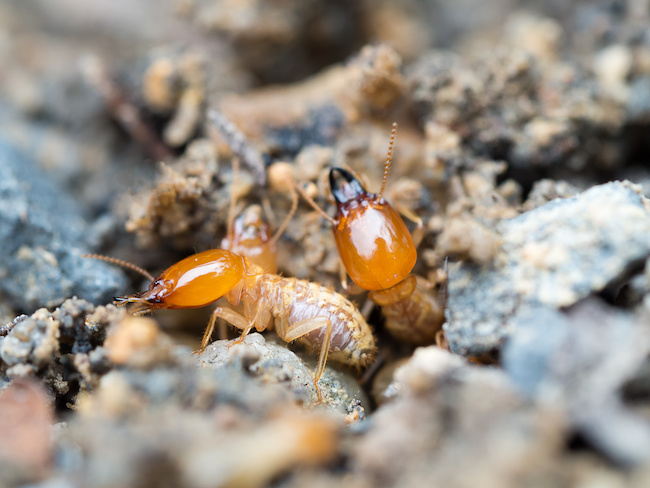Of all home invaders, few pests match the relentless tenacity of soldier termites. They are a force to be reckoned with with their imposing presence and destructive potential. These formidable defenders may be a homeowner’s worst nightmare, but understanding their unique traits is crucial for effective pest control.
Prepare to confront the challenges of termite infestations head-on and arm yourself with the knowledge needed to protect your home from these determined invaders! Plus, don’t forget that the experts here at proof. are here to lend a hand if you have an infestation!
Identifying Soldier Termites
Soldier termites play a vital role in safeguarding the community and maintaining order. These remarkable creatures have evolved unique characteristics and adaptations, making them exceptional defenders.

Close up termites or white ants destroyed.
These pests stand out among their colony members in terms of size. They are significantly larger than worker termites, measuring up to four times their size. This larger build grants them a commanding presence, serving as a visual indicator of their specialized role within the colony.
One of the most fascinating features of these termites is their impressive exoskeleton. This rigid external armor not only provides structural support but also acts as a formidable shield against potential threats. It is composed of chitin and other substances, making it remarkably sturdy and resistant to damage.
Another defining attribute is their distinctive mandibles. These strong, elongated jaws are designed for defense and combat. With their powerful mandibles, they can bite and slice through intruders and rivals with incredible force and precision.
A soldier termite’s head is crowned with antennae, which serve as their sensory hub. These antennae are instrumental in their communication within the colony. By exchanging chemical signals and vibrations, soldier termites effectively convey information about potential threats or disturbances, helping coordinate the colony’s response.
The most striking aspect of a soldier termite’s physiology is its complex compound eyes. These eyes consist of thousands of individual lenses, giving them an extraordinary ability to see in multiple directions simultaneously. Their keen vision allows them to detect even the slightest movements or changes in their environment, enabling rapid responses to potential dangers.
Soldier vs. Worker Termites
As social insects, termites exhibit a complex division of labor within their colonies. This division of labor leads to the development of various castes, with two of the most prominent being the soldier termites and the worker termites. Let’s delve into the key differences between these two essential castes:
Roles and Responsibilities:
- Worker Termites: Worker termites form the largest caste in the colony and are responsible for various tasks essential for colony survival. They construct and maintain the nest, forage for food, care for the young (nymphs), and tend to the queen and king. Their duties encompass various responsibilities that ensure the colony’s day-to-day functioning.
- Soldier Termites: As the name suggests, soldier termites serve as the colony’s defenders. They are specialized in protecting the territory from potential threats, such as predators and rival termite colonies. Their primary role is to engage in combat and safeguard the nest, making them essential for the colony’s security.
Physical Characteristics:
- Worker Termites: Workers are generally smaller in size compared to other castes. They have a soft, creamy-white body and lack the distinctive features of soldiers, such as enlarged mandibles and prominent heads.
- Soldier Termites: Soldiers, on the other hand, are larger and more robust than workers. They have well-developed, powerful mandibles that are used for defense. Their heads are typically more pronounced, reflecting their adaptation to combat.
Mandible Structure:
- Worker Termites: Worker termites have mandibles suitable for excavating, gathering food, and grooming nestmates. Their mandibles are less specialized for defense since their primary focus is supporting the colony’s infrastructure and sustenance.
- Soldier Termites: The mandibles of soldier termites are adapted explicitly for combat. They are much larger and more elongated, enabling them to inflict significant damage to intruders and protect the colony effectively.
Behavior:
- Worker Termites: Workers are diligent and hardworking insects, constantly tending to their duties. They exhibit excellent cooperation and coordination, ensuring the smooth functioning of the termite society.
- Soldier Termites: Soldiers display a more aggressive and protective demeanor. They are always on alert, ready to defend the colony at a moment’s notice. When threatened, soldiers can release defensive chemicals, further deterring potential attackers.
Reproductive Capability:
- Worker Termites: Workers are sterile and incapable of reproduction. Their primary focus is to support the colony’s needs without participating in creating new offspring.
- Soldier Termites: Soldiers are also sterile and do not reproduce like the workers. Their sole purpose is to safeguard the reproductive members of the colony (the queen and king) to ensure the colony’s continuity.
Trust proof. To Eliminate Termites!
When faced with a termite infestation, seeking the expertise of a professional pest control agency is undeniably the wisest choice, regardless of the termite type.

A one-size-fits-all approach seldom works with termites. We will develop a customized treatment plan based on the termite species, the extent of the infestation, and the unique characteristics of your property. This tailored approach ensures that the treatment is both efficient and environmentally responsible.
Don’t let termites compromise the safety and value of your property. Contact proof. Pest Control today for reliable and effective termite management! Let our experts secure your home with industry-leading termite solutions.

